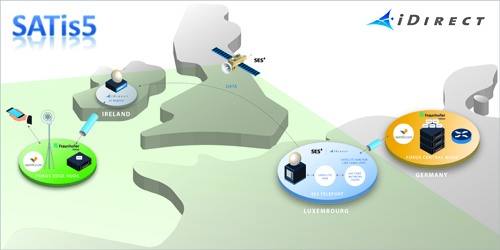The 5G standard is set to have a major impact on how wireless networks are designed and operated. At its core, 5G defines a common approach to which all access technologies can adhere. It establishes an entirely new networking architecture — “a network of networks” — with multiple access technologies such as Wi-Fi, small cells, and traditional mobile wireless networks as well as terrestrial and satellite all working in unison. In addition, the 5G standard is being designed by the wireless industry to virtualize, automate and streamline service delivery. These technologies can transform how the communications industry at large operates, and how users experience new connectivity services.
We believe that 5G will dramatically change how satellite is integrated to achieve full interoperability within the end-to-end 5G network. This creates the ultimate opportunity for the satellite industry to break out of its niche and for satellite service providers to offer a much wider range of services and empower end users anywhere in the world with consistent, reliable, high-performance experiences.
Mobile network operators will be able to complement their 5G services with satellite connectivity to offload their terrestrial networks in a large scale. They will be able to take advantage of satellite’s inherent multi-casting/broadcast functionality for new use cases, such as massive IoT or connected vehicles, while preserving high-value wireless spectrum for latency-sensitive services. Or, they can use satellite’s longer range to complement the buildout of 5G in remote areas where building terrestrial networks for enhanced broadband services is simply too cost prohibitive.
iDirect sees the movement toward 5G as a path to standards-based access for a fully converged, end-to-end network. To help drive the 5G standard and the adoption of satellite forward, iDirect has partnered with key companies in this space to further the technology innovation around 5G integration with satellite.
iDirect recently joined SATis5, a consortium sponsored by the European Space Agency (ESA), to focus on integrating satellite into 5G networks facilitated primarily through 3rd Generation Partnership Project (3GPP) standardization. SATis5 is part of the Advanced Research in Telecommunications Systems (ARTES) program of ESA. One of the main objectives of the organization is to promote the integration of space systems within the 5G Pan-EU trials.
With this multi-year project, ESA wants to showcase to the mobile industry how satellite can be used to deploy 5G across different verticals and rural and remote areas. Consortium members work to achieve this through a comprehensive testbed that includes live, over-the-air GEO and non-GEO satellite connectivity.
At the FOKUS FUSECO Forum held in Berlin on Nov. 15-16, iDirect, SES and Fraunhofer FOKUS demonstrate how satellite connectivity integrates into a 5G test network architecture. The demo comprises a Software-Defined Networking (SDN), Network Functions Virtualization (NFV), and Multi-Access Edge Computing (MEC)-enabled 5G testbed. The demonstration also showcases efficient edge delivery and network slicing of enhanced Mobile Broadband (eMBB) and massive Internet of Things (mIoT) building upon the Fraunhofer FOKUS’ Open5G core network as a proof of concept for their integration into a full 5G architecture.
Another consortium iDirect is involved in is the ESA Artes project called OSMOSIS. The objective of this program is to enhance the end-to-end hybrid network, using broadcast techniques to populate network edge CDN appliances. iDirect has had several successful demos to showcase how content at the edge and multicasting can help offload traffic for some of the MNO’s valuable 5G edge capacity.
This year we also held a successful milestone demo as part of the EU’s Horizon 2020 SaT5G consortium. We led a milestone demo along with key partners including SES at EUCnC in June that showcased a first-of-its-kind, end-to-end test leveraging 3GPP architecture over satellite into a pre-5G core network.
The work that these consortiums are driving will ultimately contribute to an easier integration of satellite into terrestrial and wireless networks. And it will help service provides worldwide reach significant new markets and shape the future of how the world connects.
At iDirect, we make it our mandate to foster industry collaboration that ensures satellite’s place in the future 5G connected world. Visit our 5G page to find out more.
